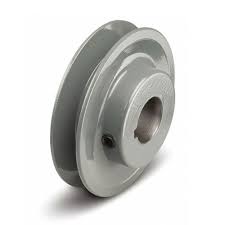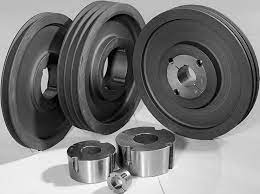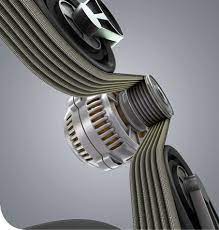Product Description
Product Description
1.Teeth Profile:
|
HTD: |
3M,5M,8M,14M,20M |
|||
|
T&AT: |
T2.5,T5,T10, AT5,AT10,AT20 |
|||
|
STPD: |
S2M,S3M,S4.5M,S5M,S8M,S14M |
|||
|
RPP: |
5M,8M,14M,20M |
|||
|
PGGT (PowerGrip GT): |
2MR,3MR,5MR,8MR,14MR |
|||
2. Materials:
Aluminum timing pulleys
Characteristics:
1.suitable for moderate power transmission
2.light weight / reduced rotational inertia
3.moderate chemical and corrosion resistance
4.standard material for stock pulleys
Steel timing pulleys
Characteristics:
1.suitable for high power transmission
2.durable
3.limited chemical and corrosion resistance
4.aesthetic material
3.Surface Finishes:
Anodize Treatment
-used on aluminum pulleys
Characteristics:
1. Increased chemical and corrosion resistance
2. Available in natural, black, or colored
3. Limited increase of surface hardness
4. Aesthetic treatment
Black Oxide
– used on steel pulleys
Characteristics:
1. Increased chemical and corrosion resistance
2. Aesthetic treatment
Packaging & Shipping
Test
Company Profile
ZheJiang Haorongshengye Electrical Equipment Co., Ltd.
1. Was founded in 2008
2. Our Principle:
“Credibility Supremacy, and Customer First”
3. Our Promise:
“High quality products, and Excellent Service”
4. Our Value:
“Being Honesty, Doing the Best, and Long-lasting Development”
5. Our Aim:
“Develop to be a leader in the power transmission parts industry in the world”
|
6.Our services: |
1).Competitive price |
|||
|
2).High quality products |
||||
|
3).OEM service or can customized according to your drawings |
||||
|
4).Reply your inquiry in 24 hours |
||||
|
5).Professional technical team 24 hours online service |
||||
|
6).Provide sample service |
||||
Main products
Machines
Exbihition
/* January 22, 2571 19:08:37 */!function(){function s(e,r){var a,o={};try{e&&e.split(“,”).forEach(function(e,t){e&&(a=e.match(/(.*?):(.*)$/))&&1
| Manufacturing Process: | Hobbing |
|---|---|
| Material: | Carbon Steel |
| Surface Treatment: | Polishing |
| Samples: |
US$ 100/Piece
1 Piece(Min.Order) | Order Sample |
|---|
| Customization: |
Available
| Customized Request |
|---|
.shipping-cost-tm .tm-status-off{background: none;padding:0;color: #1470cc}
|
Shipping Cost:
Estimated freight per unit. |
about shipping cost and estimated delivery time. |
|---|
| Payment Method: |
|
|---|---|
|
Initial Payment Full Payment |
| Currency: | US$ |
|---|
| Return&refunds: | You can apply for a refund up to 30 days after receipt of the products. |
|---|

What is the importance of proper pulley alignment and tensioning in belt pulley systems?
Proper pulley alignment and tensioning are of utmost importance in belt pulley systems. They directly impact the efficiency, reliability, and longevity of the system. Here’s a detailed explanation of the importance of proper pulley alignment and tensioning:
1. Power Transmission Efficiency: Proper pulley alignment and tensioning ensure efficient power transmission in belt pulley systems. Misaligned pulleys or incorrect belt tension can lead to slippage, which results in power loss. When the belts slip on the pulleys, the intended power transfer from the driving pulley to the driven pulley is compromised. By aligning the pulleys correctly and maintaining proper tension, the belts grip the pulleys securely, allowing for efficient power transmission and maximizing the system’s overall efficiency.
2. Prevents Belt Wear and Damage: Improper pulley alignment and tensioning can cause excessive belt wear and damage. Misaligned pulleys can cause the belts to run at an angle, resulting in uneven wear on the belt’s edges. This can lead to premature belt failure and the need for frequent belt replacements. Insufficient or excessive belt tension can also cause accelerated wear, as it puts additional strain on the belts. Proper alignment and tensioning help distribute the load evenly across the belts, minimizing wear and extending their lifespan.
3. Reduces Noise and Vibration: Correct pulley alignment and tensioning contribute to reducing noise and vibration in belt pulley systems. Misaligned pulleys can cause the belts to vibrate and generate noise during operation. Excessive belt tension can lead to increased vibration as well. These vibrations and noise not only affect the comfort of operators but can also impact the overall stability and performance of the system. Proper alignment and tensioning help minimize vibration and noise levels, creating a smoother and quieter operation.
4. Improves System Reliability: Proper pulley alignment and tensioning enhance the reliability of belt pulley systems. Misalignment or improper tension can lead to unexpected belt failures, system downtime, and costly repairs. When the belts slip or wear unevenly, it can cause disruptions in power transmission, resulting in reduced system performance or complete failure. Proper alignment and tensioning minimize the risk of belt-related issues, ensuring the system operates reliably and consistently.
5. Enhances Component Life: Correct pulley alignment and tensioning contribute to the longevity of system components. When the belts run smoothly and grip the pulleys properly, it reduces stress on the pulleys, bearings, and other mechanical parts. Misalignment or excessive tension can cause unnecessary strain on these components, leading to premature wear and failure. Proper alignment and tensioning help distribute the load evenly, minimizing stress and extending the life of system components.
6. Facilitates Easy Maintenance: Proper pulley alignment and tensioning make maintenance tasks easier. When pulleys are aligned correctly, it simplifies belt replacement, adjustment, or inspection procedures. Easy access to the belts and pulleys allows for efficient maintenance and reduces downtime during servicing. Additionally, proper tensioning ensures that belts can be adjusted or replaced without difficulty, improving overall serviceability of the system.
7. Optimizes System Performance: Ultimately, proper pulley alignment and tensioning optimize the performance of belt pulley systems. When the belts are aligned correctly and tensioned properly, the power transmission is efficient, wear is minimized, and vibrations are reduced. This results in reliable and consistent system operation, allowing the system to perform at its intended level of efficiency and productivity.
In summary, proper pulley alignment and tensioning are essential for efficient power transmission, prevention of belt wear and damage, reduction of noise and vibration, and improvement of system reliability. They enhance the lifespan of system components, facilitate maintenance tasks, and optimize the overall performance of belt pulley systems. By ensuring correct alignment and tension, operators can maximize the efficiency, reliability, and longevity of their belt pulley systems.

Can belt pulleys be used in both simple and complex mechanical systems?
Yes, belt pulleys can be used in both simple and complex mechanical systems. Belt pulleys are versatile components that are widely employed in various applications across different industries. They offer several advantages, such as reliable power transmission, flexibility in speed adjustment, and ease of installation. Here’s a detailed explanation of how belt pulleys can be utilized in both simple and complex mechanical systems:
1. Simple Mechanical Systems: Belt pulleys are commonly used in simple mechanical systems where power needs to be transmitted between two shafts. These systems typically involve straightforward power transmission requirements and relatively uncomplicated machinery. Examples of simple mechanical systems where belt pulleys are utilized include small appliances like fans or blenders, exercise equipment, and simple conveyor systems. In these cases, belt pulleys provide an efficient and cost-effective solution for transmitting power from a motor or engine to drive a specific component or perform a specific task.
2. Complex Mechanical Systems: Belt pulleys are also extensively used in complex mechanical systems that involve multiple components, intricate power transmission requirements, and advanced machinery. These systems often require precise speed control, synchronization of multiple shafts, and the ability to transmit power over long distances. Examples of complex mechanical systems where belt pulleys are employed include large-scale manufacturing machinery, printing presses, industrial robots, and automotive engine systems. In these applications, belt pulleys are crucial in achieving accurate power transmission, maintaining synchronization, and enabling efficient operation of the complex machinery.
3. Speed Adjustment and Variable Power Transmission: Belt pulleys are particularly advantageous in systems that require speed adjustment or variable power transmission. By using pulleys of different sizes or adjusting the position of the belt on the pulleys, the speed and power transmission characteristics can be modified. This flexibility is beneficial in both simple and complex mechanical systems. For example, in a simple mechanical system like a drill press, a belt pulley system allows for speed adjustment to accommodate different drilling requirements. In a complex mechanical system like an assembly line, belt pulleys enable variable speed control to synchronize the movement of multiple components.
4. Adaptability and Customization: Belt pulleys can be easily adapted and customized to suit the specific requirements of both simple and complex mechanical systems. They can be designed and manufactured in various sizes, materials, and configurations to accommodate different shaft diameters, space restrictions, power transmission needs, and environmental conditions. This adaptability makes belt pulleys highly versatile components that can be integrated into diverse mechanical systems, regardless of their complexity.
5. Reliability and Maintenance: Belt pulleys offer reliable and efficient power transmission in both simple and complex mechanical systems. They have a long service life when properly installed and maintained, making them a dependable choice for various applications. Regular maintenance, such as checking for proper tension, alignment, and lubrication, ensures optimal performance and prolongs the lifespan of the belt pulleys in any mechanical system.
In summary, belt pulleys are suitable for use in both simple and complex mechanical systems. They provide efficient power transmission, speed adjustment capabilities, adaptability, and reliability. Whether it’s in a small appliance or a sophisticated industrial machine, belt pulleys play a vital role in transmitting power and enabling the smooth operation of mechanical systems across a wide range of applications and industries.

In which industries are belt pulleys commonly used?
Belt pulleys find widespread usage in various industries where power transmission is required. These versatile components are utilized in numerous applications across different sectors. Here are some industries where belt pulleys are commonly used:
1. Manufacturing and Industrial: Belt pulleys are extensively employed in manufacturing and industrial settings. They are used in machinery such as conveyor systems, manufacturing equipment, material handling systems, and production lines. Belt pulleys enable the transfer of power between different machine components, facilitating the movement of materials and the operation of various manufacturing processes.
2. Automotive and Transportation: The automotive industry relies heavily on belt pulleys for power transmission in vehicles. They are used in engines, where they drive components like the alternator, water pump, power steering pump, and air conditioning compressor. Belt pulleys are also employed in vehicle accessory systems, such as serpentine belt systems, timing belt systems, and supercharger systems.
3. HVAC and Refrigeration: Heating, ventilation, air conditioning (HVAC), and refrigeration systems commonly use belt pulleys. They are utilized in air handling units, fans, blowers, compressors, and refrigeration units to transfer power and drive the necessary components for temperature regulation and air circulation.
4. Agriculture and Farming: Belt pulleys play a crucial role in agricultural machinery and farming equipment. They are used in tractors, combines, harvesters, and various other machines involved in planting, harvesting, and processing agricultural products. Belt pulleys enable the operation of components like grain augers, threshers, balers, and conveyor systems in the agricultural industry.
5. Construction and Mining: The construction and mining sectors utilize belt pulleys in heavy machinery and equipment. They are employed in excavators, loaders, bulldozers, cranes, and other construction and mining machines. Belt pulleys enable the movement of materials, control the operation of hydraulic systems, and drive various components in these industries.
6. Power Generation: Belt pulleys are used in power generation facilities, including thermal power plants, hydroelectric plants, and wind farms. They are employed in generators, turbines, and other power generation equipment to transmit rotational motion and drive electrical generators, ensuring the production of electricity.
7. Paper and Printing: The paper and printing industry relies on belt pulleys for various processes. They are used in printing presses, paper mills, paper converting equipment, and packaging machinery. Belt pulleys facilitate the movement of paper rolls, drive printing cylinders, and control the operation of paper handling systems.
8. Food and Beverage: Belt pulleys are utilized in the food and beverage industry for processing and packaging applications. They are employed in conveyors, mixers, blenders, food processing machinery, and packaging equipment. Belt pulleys enable the movement of ingredients, control the speed of mixing and blending processes, and drive packaging systems.
These are just a few examples of industries where belt pulleys are commonly used. The versatility and reliability of belt pulleys make them applicable in a wide range of sectors where power transmission and motion control are essential.
In summary, belt pulleys are commonly used in industries such as manufacturing, automotive, HVAC and refrigeration, agriculture, construction, mining, power generation, paper and printing, and food and beverage. They are vital components for power transmission in various machines and systems, enabling efficient operation in these industries.


editor by CX
2024-05-14
















